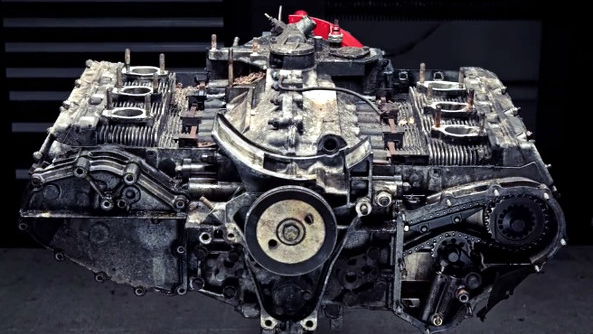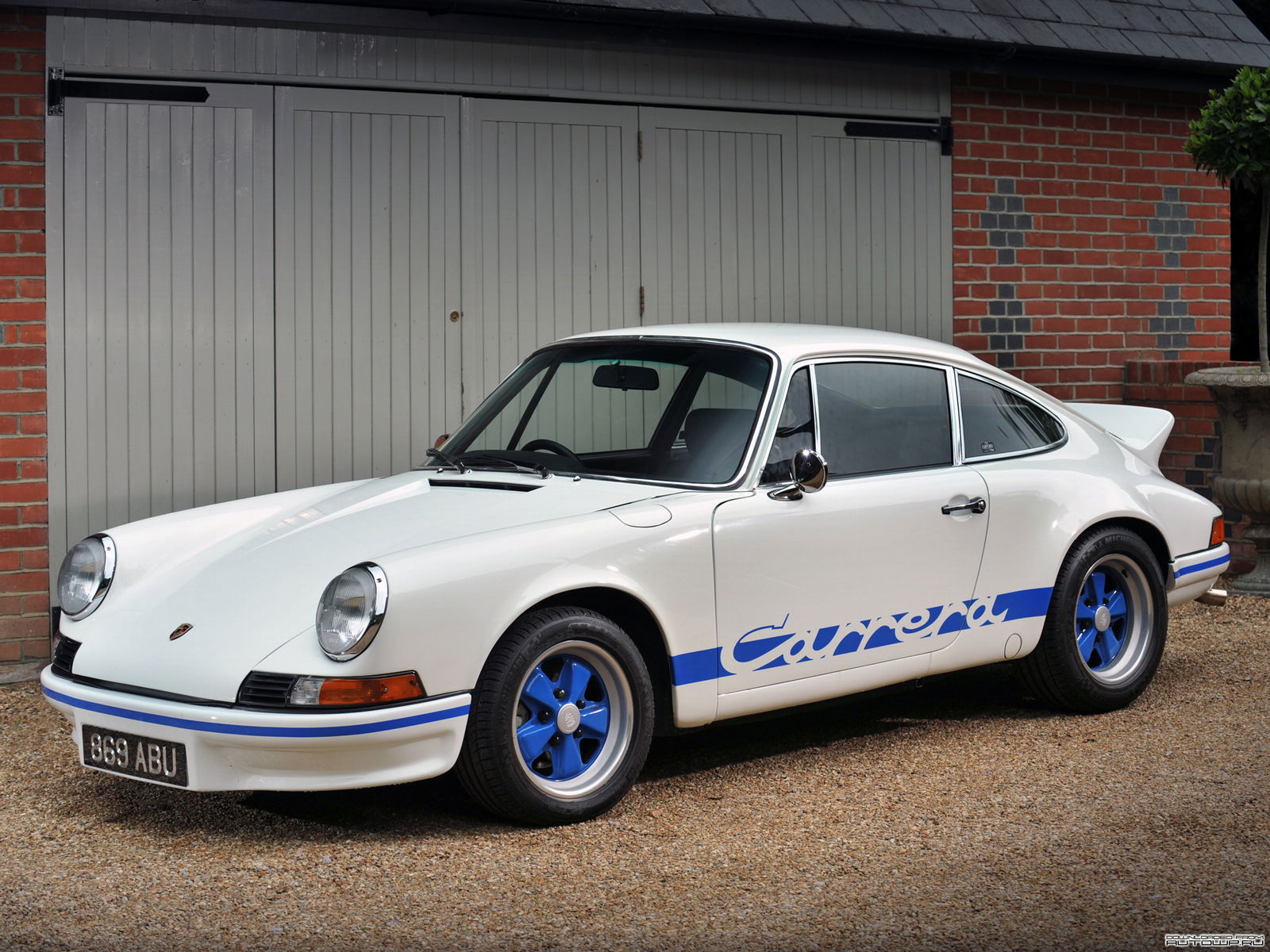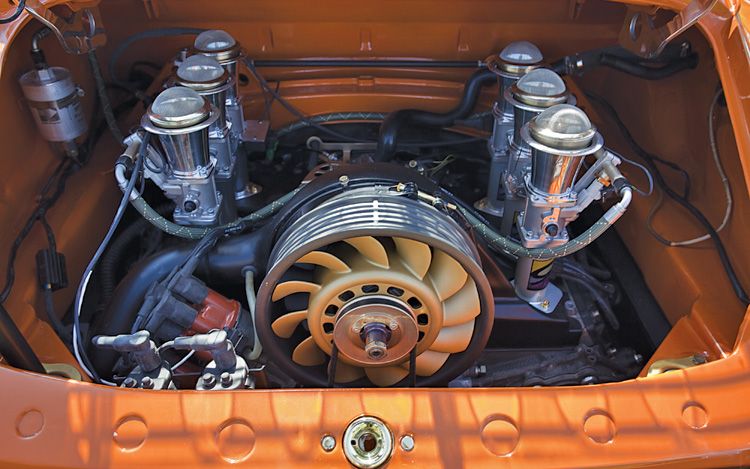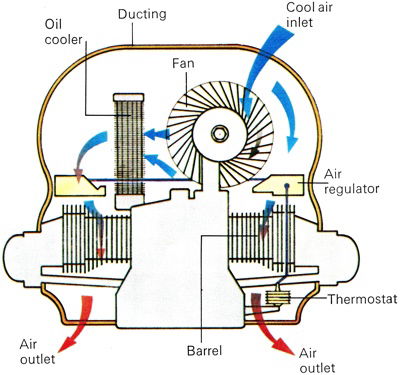Air Cooling - What It Is And Why It's A Thing Of The Past

Water-based cooling has been practiced for over 100 years, using the temperature difference between hot water and the cold incoming air to transfer unwanted heat away from your powertrain. And yet at one time, using simple airflow to cool your engine was prominent in the car world.
Engines designed for air cooling are configured differently to those cooled using water, with the most obvious difference being the use of fins covering the outside of the cylinder heads and cylinders. These days, this format of engine is only really common on motorbikes and quad-bikes, showing that only small capacity engines are trusted to cope with such a simple form of cooling.
The principles of air cooling follow those stated in my last article on cooling, with one of the main components being surface area. To maximise heat transfer, a large surface allows for more heat to be distributed to the surroundings rather than collecting into a small area of intense heat which would clog up and inevitably lead to overheating.

So the use of fins covering most of the engine block allows for the heat from the engine to be released over a much larger surface area than if the fins were absent, giving the powertrain much more chance of staying cool under load. The airflow is channelled strategically throughout these fins from an inlet (like the rear grill on old 911s and VW Beetles), allowing for convection (heat transfer) between the cold, fast moving air and the heat energy being produced by the engine’s combustion.
Many car companies practiced air cooling, with the most famous marques being Porsche and Volkswagen who for decades used simple air flow to cool their flat-four or flat-six engines successfully. But as petrolheads became hungrier and hungrier for more power, the reliability and capability of these basic cooling systems began to diminish.
A water-cooled engine uses a closed loop cooling system; this means that the use of a waterpump and cooling fan can be in constant use to keep the flow of coolant coursing throughout the engine with the fan keeping it cool even when the car is stationary.

On the other hand, air-cooling is an open system which relies massively upon a constant flow of air entering the engine bay, which is not always possible. Despite the use of large fans to try and suck air in for cooling, the heat generated by the larger capacity engines began to overcome the cooling systems, especially when sitting in traffic or driving at speeds that were not conducive to effective airflow. Less cold air was passing through the cooling fins results in a lack of a heat transfer from the engine to the surroundings.
Air-cooling did have its benefits though: weight was saved due to the lack of water and heat exchangers needed for a closed loop cooling system and maintenance was non-existent, unless some damage had been inflicted upon the cooling fins.
Nowadays, this old-school method of cooling is kept to small capacity engines due to the lack of heat they produce compared to larger, more powerful units. In the case of bikes and quads, the engine is generally exposed to the elements rather than covered, meaning efficient airflow can be achieved.

Cooling has moved on leaps and bounds since the days of air-cooling and there doesn’t seem to be any route back into the car market for the practice. Some diehard 911 fans may still pine after the distinctive feel of the air-cooled flat-sixes, but considering even the Carrera is now twin-turbocharged and even more powerful than before, there really is no way back.
There is something satisfying about the accuracy of engineering in designing an air-cooled engine with its rows of fins strategically positioned and it is startling nowadays to imagine performance cars without a major source of coolant. But due to a power battle and the inherent necessity of reliability in the automotive world, air-cooling must now stay in the history books, where it sadly belongs.
Comments
Which is why I like the 993 so much.
Aor cooled engines are fun until you get stuck in traffic in the heat of a tropical country
Oh. So that is what the black thing was. Probably should have read the VW Beetle books I have.
It’s wonderful that such old cars and engines still cross the country and after few decades get their first completete overhaul.
https://www.youtube.com/watch?v=_nq8VzNC-Gs
HEY! You guys didn’t even mention the infamous chevy corvair! which is also an air-cooled rear engine rwd car! (my personal one so you guys know what I’m talking about!)
Now I’ll get a lot of hate for this but….
Air cooling is great and they moved on away from air cooling because of pollution regulations (as far as i have heard) and the mentioned performance limitation that it causes. (Hotter engines are more prone to pre-detonate the gas, requiring higher octanes).
A fun fact though is that a big majority ofengine failures are caused by failing water cooling elements. For instance if your coolant pump stops or you lose all of your coolant, your engine will be toast very quickly. Other issues may include the fact that if the correct coolant isn’t used it may freeze and crack the block..
Edit: air cooling isn’t perfect.. it has other limitations such as : an engine running too hot in hotter climate, potentially cracking the block by pouring cold water over the hot block.. cooling an engine too much which would cause increased wear as well as increased gas consumption..
And lastly: most air cooled engines offer poor cabin heating, in a water cooled engine the heat is transferred from the coolant into another system which heats the cabin / interior. In air cooled engines the options would be limited down to getting exhaust gasses heating the water to hear the cabin or electric heating or the famous oil heater systems which use the hot (warm) engine oil to heat the cabin.
You can still run big power reliably through Aircooled engines considering they have had over 50 years of tuning on the same engines they’re still very impressive to what they started out as :) just take a look at the Porsche 962 <3
“Nowadays, this old-school method of cooling is kept to small capacity engines due to the lack of heat they produce compared to larger, more powerful units”
Ok then this must be sci-fi- 12,7L V8 with turbocharger - “The output parameters of original directly air-cooled TATRA engines range from 230 kW to 325 kW, or 1,400 Nm to 2,100 Nm.”
Airplane engines are still for the most part air-cooled - and they get massive. I was talking to someone earlier today with a Cessna 182, powered by a 7.7l Continental flat six; I know of other air-cooled airplane engines up to 9.5l, and that’s not including radials. Granted, they have propellers to ensure lots of airflow and typically don’t spend much time on the ground or at low speed. They also don’t typically go above 3000 rpm.
Pagination